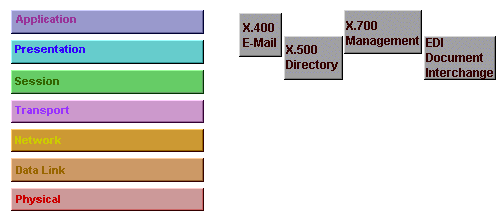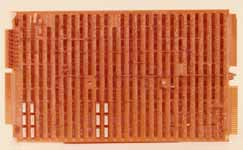
NETWORK-DEPENDENT LAYERS
To write one standard to cover all these would be unwieldy. Therfore the standard has been divided into seven layers.
Layers 1 to 3 of the model are referred to as network-dependent because they depend on the transmission facilities employed, this might be a direct link, a private network, or a public network, or a combination of these. So there is range of different alternative protocols. Above layer 3, connections are between end-systems only and thus are concerned with the nature of communications rather than how the links are achieved. Layers 1 to 3 enable layer 4 to achieve inter-connection in terms of reliable data transfer; layers 5 to 7 are focused on interworking between application processes.
| Host | Network Hops | Network Hops | Host | |||
| Application | Application | |||||
| Presentation | Presentation | |||||
| Session | Session | |||||
| Transport | Transport | |||||
| Network | Network | Network | Network | |||
| Link | Link | Link | Link | |||
| Physical | Physical | Physical | Physical |
Where the communication is through a network then the network layers communicate with their counterpart in the nearest network node, the higher layers are end to end and are carried transparently accross the network.
Physical layer (1)
The physical layer provides the means to transfer data in the form of binary
digits over a continuous physical communications path and is thus concerned
with the electrical and mechanical requirements of such transmission and of
system activation and deactivation.
Standards covering electrical characteristics, voltage levels, earthing arrangements, mechanical specifications, pin connector design, cable lengths, timing, data rates and so on are fairly well established.
Data-Link Layer (2)
The data-link layer provides 'framing', i.e. the determination of which electrical
or other signals represent bits and characters, for data transfer across a physical
connection, and provides some error detection and recovery. Where recovery is
not possible, the network layer is notified of the error.
Traditionally, protocols have relied on the presence of additional bits in
the data stream for character framing (Teletype of asynchronous protocols) or
have defined additional characters for synchronization and control ('byte-oriented'
synchronous protocols such as IBM BSC). The later approach is for 'bit-oriented'
synchronous protocols with a variable-length fixed format frame (e.g. HDLC and
IBM SDLC).
The data-link layer may use more than one physical connection to support a single data-link connection and in such cases will be responsible for ensuring that data are delivered to the network layer in correct sequences. Where a continuous physical medium connects more than two end-systems, e.g. a local area network, the data-link layer may include a basic routing function, e.g. CSMA/CD and token-passing protocols for local area networks.
Network Layer (3)
The basic function of the network layer is the inter-connections of data-link
communication paths into a global network which connects all open systems. Thus,
the network layer performs both end-to-end addressing and routing functions,
to enable the end-systems to exchange data. There are many network protocols
each optimised to a greater or lesser extent to meet particular requirements
for the transmission of data. Circuit-switched X.21 networks, X.25 packet-switched
networks (e.g. British Telecom's Public Network) and local area networks are
all examples of network protocols or subnetworks in this context.
The network layer is thus ultimately responsible for routing a communication between the open systems involved. This has the implication that the network addresses are globally unique.
Transport Layer (4)
The transport layer can be regarded as providing a reliable, network independent,
end-to-end service. In addition, facilities are available for optimising network
costs, e.g. by multiplexing several transport connection onto a single network
connection, or quality of service, including the ability to use several network
connections to carry the load of a single transport connection. These are 5
classes or levels of service currently defined:
- 0 - Simple class - compatible with ITU-T (CCITT) recommendations for teletex
- 1 - Basic error recovery class - with minimal overheads but able to recover from network signalled error
- 2 - Multiplexing class - allowing several transport connections to be carried on a single network connection, but with no error recovery
- 3 - Error recovery & multiplexing class - as 2, with the ability to mask errors shown by the networks
- 4 - Error detection & recovery class - as 3, with the detection of errors
occurring as a result of poor network service, e.g. data loss of corruption,
mis-sequencing, duplication.
Choice of class can be negotiated at the time of connection, depending on
the nature of the underlying network and user requirements. A transport address
is concerned only with routing within an end-system and can therefore be made
unique without reference to other end-systems.
The higher layers
The transport layer, the highest with any responsibility for the transportation of data, is designed to relieve the higher layers of any concern about service or the types of network over which the data transfer is conducted. The function of the higher layers can thus be focussed on the issue of inter-working between the end-processes, with little or no reference to the inter-connection between the physical systems. The higher layer protocols thus perform common functions that are independent of data transfer, such as the co-ordination associated with a file transfer.
Session Layer (5)
For communicating application processes to be able to exchange information, a relationship must be established to manage and co-ordinate the dialogue. The session layer provides dialogue management by negotiating the type of interaction to be used, e.g. simultaneous, two-day alternate, etc., at the time of session establishment. It then controls access to services. The most fundamental aspects of such control are concerned with data flow direction and with ensuring an orderly end of a communication once all data have arrived and been accepted at the destination. The session layer can also provide a data recovery service in the event of data loss or temporary failure of any component in the communications path.
Presentation Layer (6)
The presentation layer is responsible for making the information transferred comprehensible to the receiving system. Each system will have its own particular encoding rules and data structures for representing information - concrete syntax in OSI terms. The presentation layer allows the systems to negotiate a concrete transfer syntax as a common point of reference, which can then either be used directly or be converted by one or both of the end-systems for internal use.
Application Layer (7)
The application layer provides the interface between the OSI communications environment and the application processes using it. It provides a set of common application service elements for management and activation of resources in support of the communication, i.e. the basic functionality that is needed for all communication in the distributed OSI environment. In addition, there are a number of specific application service elements which provide support for the 'context' of communication, including those described in the preceding chapter.
Concept Of Layers
A telcommunication protocol standard might include such things such as, electoronic mail, file transfer, graphics encryption, compression, error detection correction flow control, transaction service, distributed database, virtual terminal, multiplexing many calls onto one link, switching, speed conversion.
Each layer carries information for the layer above it and provides "added
value" to the layer below it,
| Services | Functions | Examples | |
| Application Layer | Provides all sevices directly comprehensible to the user | electronic mail
file transfer transaction service distributed database virtual terminal job transfer and manipulation |
|
| Presentation Layer | Representation and manipulation of structured data
data transformation data formatting syntax selection provision of presentation connections |
session establishment request
presentation image negotation and re-negotation data transformation and formatting special purpose transformations session termination request |
encryption
compression syntax conversion graphics |
| Session Layer | organise and synchronize data
controls the right to, transmit data, alter shared data, application oriented error control and resyncronization session-connection establishment session-connection release normal data exchange quarantin service expedited data exchange |
session flow control
eg two-way-simultaneous two-way-alternate monologue-interation maintain continuity of connection |
teletex S62143 |
| Transport Layer | Network independant transparent transfer of data
location independant transport addresses class of service selection 1 - class of service selection 2 - service availability block size |
mapping transport-address onto network address
multiplexing end-to-end transport-connections onto network-connections |
0 - simple class
1 - basic class error recovery 2 - multiplexing class 3 - error reovery and multiplex class 4 - error detection and recovery class teletex s70 |
| Network layer | Routing (via intermediate nodes) and switching multiplexing flow control | X.25 virtual circuit
Datagram network Local area network circuit switched network |
|
| Link Layer | Error conrrection
flow control |
HDLC | |
| Physical layer | Bit transmission | V24 V25 X.21 |
Principles used to determine the seven layers in the reference model
It may be difficult to prove that any particular layering selected is the
best possible solution. However, there are general principles which can be applied
to the question of where a boundary should be placed and how many boundaries
should be placed.
1 - do not create so many layers as to make the system engineering task of
describing and integrating the layers more difficult than necessary.
2 - Create a boundary at a point where the description of services can be
small and the number of interactions across the boundary are minimised.
3 - Create separate layers to handle functions that are manifestly different
in the process performed or the technology involved;
4 - Collect similar functions into the same layer;
5 - Select boundaries at a point which past experience has demonstrated to
be successful;
6 - Create a layer of easily localized functions so that the layer could be
totally redesigned and its protocols changed in a major way to take advantage
of new advances in architectural, hardware or software technology without changing
the services expected from and provided to the adjacent layers;
7 - Create a boundary where it may be useful at some point in time to have
the corresponding interface standardised;
Note 1: Advantages and drawbacks of standardizing internal interfaces within
open systems are not considered in the recommendation. In particular, mention
of, or reference to principle 7, should not be taken to imply usefulness of
standards for such internal interfaces.
Note 2: It is important to note that OSI per se does not require interfaces
within open systems to be standardised. Moreover, whenever standards for such
interfaces are defined, adherence to such internal interface standards can in
no way be considered as a condition of openness.
8 - create a layer where there is a need for a different level of abstraction
in the handling of data, e.g. morphology, syntax, semantics;
9 - allow changes of functions or protocols to be made within a layer without
affecting other layers;
10- create for each layer boundaries with its upper and lower layer only;
Similar principles for sublayering
11 - create further subgrouping and organization of functions to form sublayers
within a layer in cases where distinct communication services need it;
12 - create, where needed, two or more sublayers with a common, and therefore
minimal functionality to allow interface operation with adjacent layers;
13 - Allow by-passing of sublayers.

